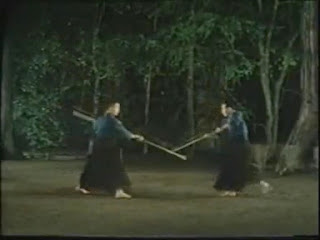A long discourse on the halberd is best left for some other time, however there is a tendency to lump all polearms together. It is important to note that the spear is entirely different from a glaive in terms of its use.
The use of the spear in the fashion of a quarterstaff or glaive is essentially the unorthodox method of the employment of a spear. The orthodox use of the spear is to thrust down the centre.
It is a common tactic to attack the spear by beating, binding or levering it off the centre. Therefore chopping with the spear in the fashion of a glaive is not the ideal use of the weapon - this method becomes useful in a symmetrical engagement (with another spear) or when the centre has been lost but should be considered the unorthodox.
The glaive, on the other hand, is not best used as a spear - there are many examples of its use as such but in this case, the spear-like use of the glaive is unorthodox.
As my prefered Japanese example is the Katori style I have included some captures from their method to illustrate how different their use of this weapon is compared to the spear. It is however directly comparable to European methods of quarterstaff and glaive.
Naginata of the Katori Style
The grip is a normal one taking the weapon in the middle, in a similar fashion to quarterstaff etc.
In this sequence the grip has been changed so the front hand is also holding in the reverse-grip position - this is also seen in European long weapons especially quarterstaff.
Half-swording sequence.
Again, attacking and avoiding these arm cuts is a constant theme.
To summarise, the best use of a spear, especially against a shorter weapon, is to thrust down the centre - don't chop like a glaive.
The use of the spear in the fashion of a quarterstaff or glaive is essentially the unorthodox method of the employment of a spear. The orthodox use of the spear is to thrust down the centre.
It is a common tactic to attack the spear by beating, binding or levering it off the centre. Therefore chopping with the spear in the fashion of a glaive is not the ideal use of the weapon - this method becomes useful in a symmetrical engagement (with another spear) or when the centre has been lost but should be considered the unorthodox.
The glaive, on the other hand, is not best used as a spear - there are many examples of its use as such but in this case, the spear-like use of the glaive is unorthodox.
As my prefered Japanese example is the Katori style I have included some captures from their method to illustrate how different their use of this weapon is compared to the spear. It is however directly comparable to European methods of quarterstaff and glaive.
Naginata of the Katori Style
The grip is a normal one taking the weapon in the middle, in a similar fashion to quarterstaff etc.
It is harder for the sword to gain the same leverage advantage in a good bind as against the spear, here the glaive has the advantage of leverage (due to the hand position) albeit with less distance.
A grip change with both in backward guards.
The glaive maintains the central grip and does not thrust the weapon through the hands.
The legs are still targets. In this central grip the weapon is essentially a one-handed cutting weapon in one hand and a one-handed blocking weapon (held with reverse grip) in the other, and thus has something in common with nito (using a weapon in each hand). Here the sword tries to use a bind to work in as is seen against the spear.
As with the spear, the glaive needs to maintain sufficient range.
Striking (or parrying) with the butt is much more prevalent than with the spear, a direct result of the chopping rather than thrusting style of attack.
Again the hands/forearms are significant targets, here the top hand has been released to avoid the naginata.
On the lunge note there is no thrust through the hands.
In this sequence the grip has been changed so the front hand is also holding in the reverse-grip position - this is also seen in European long weapons especially quarterstaff.
Half-swording sequence.
Again, attacking and avoiding these arm cuts is a constant theme.
To summarise, the best use of a spear, especially against a shorter weapon, is to thrust down the centre - don't chop like a glaive.














